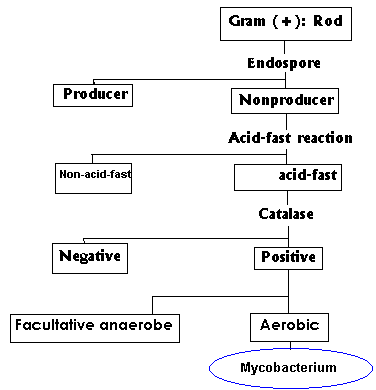

Tim Remley - Mycobacterium
This isolate was obtained from the top part of the non-lit, Winogradsky column. It was plated and later streaked onto agar plates. The optimal growth for this isolate occurred in the incubation room. Colonies formed in two days and were a dull-yellow color.
The first test performed was the Gram stain. This isolate was Gram(+) and the morphology of the cells were slender rods, not in clusters. The gram stain was weak but, as I learned later on in the identification process, this was a classic characteristic of my isolate. Next, the endospore test was performed and the insolate was a non-spore former. The final test to identify the genus was the acid-fast test. My bacteria was acid-fast due to the thick waxy cell walls. The flow chart in the lab manual identified my unknown isolate as Group II Mycobacterium.
The next step in the identification process was to confirm the genus and try to identify the species. I, looked in the Bergey’s Manual to find out what further tests could confirm my bacteria. Catalase test and Nitrate tests were performed to confirm my genus and help distinguish the species. It was Catalase(+) and Nitrate(+); this confirmed my genus but didn’t identify my species. A main differentiating factor for mycobacteria is whether it is a slow grower (more than 7 days for colonies to appear) or a fast grower (less than 7 days for colonies to appear). My bacteria was a fast grower. I used the fast grower test chart to find out my species but, the only tests that could be performed in the micro. lab were the Catalase and Nitrate. These two tests did not eliminate enough possible species to identify my mycobacteria’s species.
I performed further tests to find out characteristics of my bacteria. These tests included citrate(-), fermentation(Sucrose and Lactose, acid no gas), lipase(+), IMViC, methyl red(+), amylase(-), cysteine desulfhydrase(-), motility(-), indole(-), and urease(-). According to the Bergey’s Manual, mycobacteria is slender rod shaped, that is acid fast, aerobic, slow growing and free living obligative pathogen found widely distributed in soil and water. This is constituent with the location where the bacteria was found, from Big Walnut Creek that is behind a waste-water plant.

